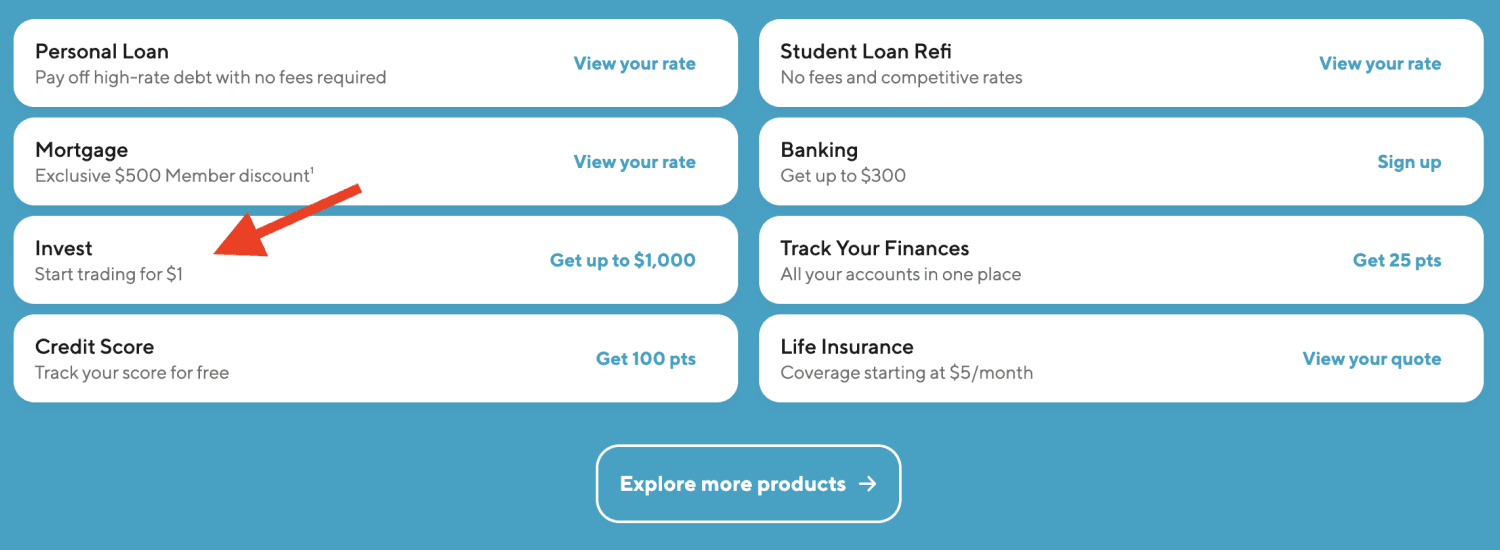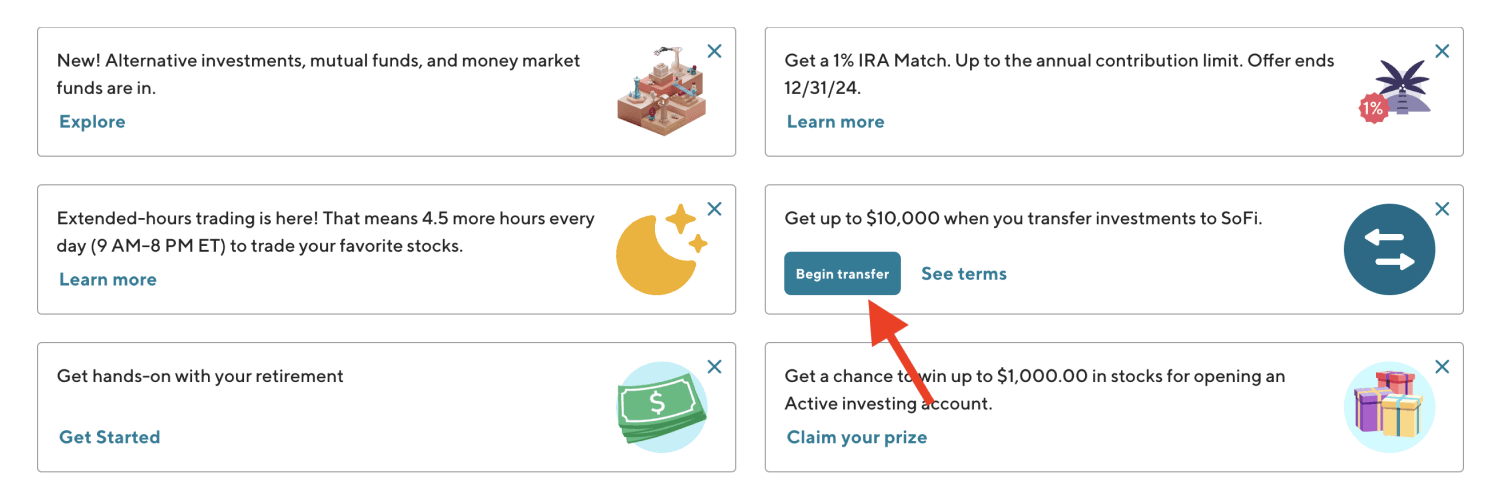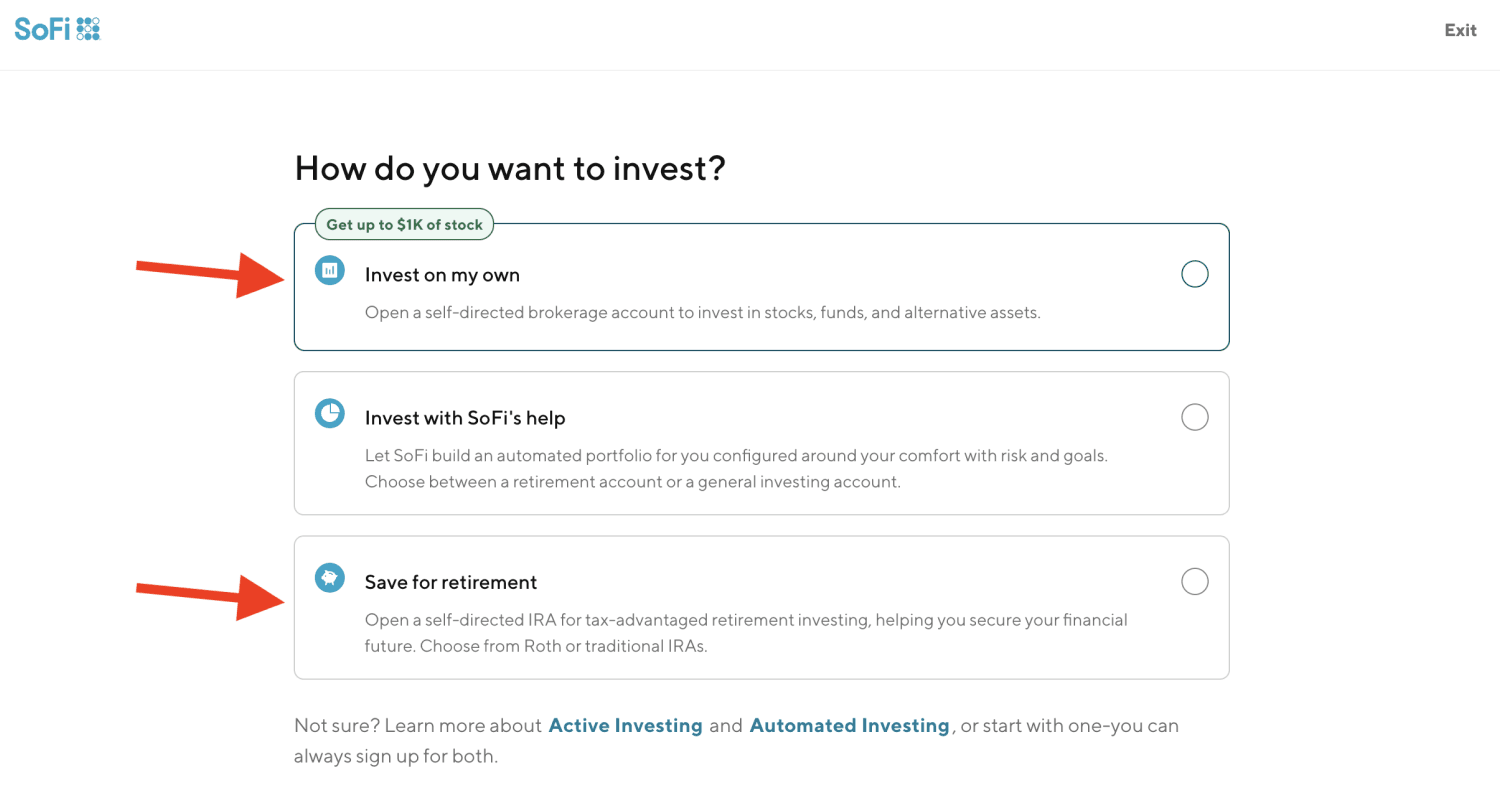You’re about to see our list of ideas for how to invest $10K. This isn’t investment advice — just some thoughtful options, some of which I’ve personally used and found effective.
Ten thousand dollars in investable cash may not be life-changing, but it can provide a healthy boost to your portfolio, and it opens the door to a variety of investment options.
7 best ways to invest $10K
- Leverage broker signup and transfer bonuses
- Max out an IRA and get free money
- Build a foundation of index funds
- Buy individual stocks for growth and passive income
- Hire a financial advisor
- Fund a 529 account
- Ladder CDs
1. Leverage broker signup and transfer bonuses
One effective way to maximize your $10K investment is by leveraging broker signup and transfer bonuses.
Many brokerage firms offer attractive incentives to new customers or those transferring their accounts from another firm. These bonuses can range from a few hundred to even thousands of dollars, depending on the amount you invest or transfer.
For example, SoFi Invest® offers a bonus of up to $1,000 in stock when you open a new Active Invest account and fund the account with at least $25 within the first 30 days.
Here are step-by-step instructions to get this bonus:
- Sign up for an account. Select Go to site to head to SoFi’s Invest landing page. Then, select Trade now to sign up.
- Complete your application. Provide the required personal information to create an account. This includes name, address, phone number and Social Security number.
- Create an Invest account. Select Invest from your SoFi hub once you’ve created your main SoFi account. Then, fund it with at least $25 within 30 days for a chance at up to $1,000 in bonus stock.

- Begin transfer. Scroll down to the Features to explore section and select Begin transfer.

- Complete your transfer. Follow SoFi’s instructions to create either a SoFi Invest Active brokerage or Active retirement account and transfer in your assets from an outside broker. Transfer at least $5,000 to get the $100 bonus.

Pros
- Extra funds. Get additional money you can invest, increasing your initial capital without any extra cost.
- Access to superior platforms. Moving to a new broker may give you access to more advanced trading tools and platforms, enhancing your trading experience.
Cons
- Limited availability. Not all brokers offer signup or transfer bonuses, and those that do might not always be the best fit for your investment needs.
- Lock-in periods. Some bonuses require you to keep your funds with the broker for a set period, limiting your liquidity and flexibility.
- Must maintain your contribution to get the match. All three brokers that offer IRA matches require you to maintain your contribution amount over a certain period to get the full match.
Our top broker picks for investing $10K

- Trade stocks, options, ETFs, mutual funds, alternative asset funds
- $0 commission on stocks, ETFs and options with no options contract fees
- Get up to $1,000 in stock when you open and fund a new account within 45 days
- Access to a financial planner
Terms and conditions apply*. For 401k rollovers, existing SoFi IRA members must complete 401k rollovers via this link For SoFi members without a SoFi IRA, a SoFi IRA must first be opened, and 401k rollover must be completed utilizing Capitalize via this link. SoFi and Capitalize will charge no additional fees to process a 401(k) rollover to a SoFi IRA. SoFi is not liable for any costs incurred from the existing 401k provider for rollover. Please check with your 401k provider for any fees or costs associated with the rollover. For IRA contributions, only deposits made via ACH and cash transfer from SoFi Bank accounts are eligible for the match. Click here for the 1% Match terms and conditions.

- Trade stocks, ETFs, options, futures and bonds all in one place
- $0 commissions on stocks, ETFs and equity options, with low contract fees
- Deposit or transfer $10,000+ to earn a 2% Match Bonus. Plus: Get a $100 transfer fee reimbursement on your first brokerage transfer of $2,000 or more. T&C apply.

- Trade $0 commission stocks, ETFs, futures and options with as little as $1
- After-hours trading available
- Earn 3.50% interest on uninvested cash with Gold
- 24/7 customer support
2. Max out an IRA and get free money
Individual retirement accounts (IRAs) are versatile investment accounts that offer tax benefits for saving for retirement.
These tax-advantaged accounts let you invest in many of the same assets available to you in a taxable brokerage account but with the addition of tax incentives, making them a foundational account for all investors.
The traditional IRA offers upfront tax benefits through deductible contributions, and you pay taxes on your money when you withdraw it in retirement. If you think you’ll be in a lower income tax bracket later in life, investing through a traditional IRA could be advantageous.
On the other hand, Roth IRAs let you pay taxes now to withdraw funds tax-free later on. If higher taxes are likely in your future, you may benefit from paying taxes today at a lower rate.
For 2026, the contribution limit for all your traditional and Roth IRAs is $7,500 ($8,500 if you’re age 50 or older). If you’re married and you and your spouse file a joint return, you can each contribute to separate IRAs. With $10K, you could max out one spouse’s IRA and use the remainder to fund the other.
This is where it gets exciting.
More and more brokers are starting to offer IRA matching as a new incentive for customers, something that’s traditionally been reserved for 401(k)s.
The first to roll out this new feature was Robinhood, followed by SoFi Invest® and Webull.
The process to get the match is mostly the same for all three brokers: sign up for an IRA, contribute money and get the match.
However, ensure you read the terms and conditions carefully to understand any requirements or restrictions. All three brokers require you to maintain your contribution balance over a certain period to get the full match.
Here’s more on each provider’s IRA match program:
| Broker | IRA match | Requirements | Expiration |
|---|---|---|---|
| Robinhood |
| Maintain your contribution amount for at least 5 years. | None. |
| Webull | Get a 3.5% match on contributions or transfers. | Maintain your balance until you receive the final bonus installment. | October 23, 2024 |
Pros
- Tax benefits. Choose from a tax deduction today or tax-free withdrawals in retirement, or both.
- Wide range of allowable investments. Invest in traditional assets like stocks and bonds in a regular IRA or alternative assets like real estate and cryptocurrency in a self-directed IRA.
- IRA matches. A growing number of brokers are offering IRA matches that pay between 1% and 3.5% on contributions.
Cons
- Contribution limits. The maximum you can contribute to an IRA in 2024 is $7,000 ($8,000 if age 50 or older).
- Withdrawal penalties. Withdrawals before age 59 and a half will be subject to regular income taxes and a 10% early-withdrawal penalty.
- Must maintain your contribution to get the match. All three brokers that offer IRA matches require you to maintain your contribution amount over a certain period to get the full match.
3. Build a foundation of index funds
Index funds are exchange-traded funds (ETFs) and mutual funds designed to track and achieve roughly the same return as a particular market index, such as the S&P 500 or the Nasdaq Composite.
To accomplish this, fund managers invest in the securities of companies included in the selected index. For instance, the Vanguard 500 Index Fund ETF (VOO) invests in all the stocks in the S&P 500.
Index funds are a great option if you’re looking for an effortless investment for your $10K because they give you instant diversification across various stocks and sectors. And since index fund managers only need to passively track a fixed index of securities, it involves fewer fees and expenses passed on to the investor.
Billionaire investor Warren Buffett recommends index funds for most people. And, hey, he owns two in his Berkshire Hathaway portfolio — VOO and the SPDR S&P 500 ETF Trust (SPY).
Pros
- Uncomplicated investing. No need to research and analyze individual stocks or other assets.
- Broad market exposure. Invest in numerous assets through a single fund purchase.
- Lower risk through broad diversification. A single fund purchase provides instant diversification.
Cons
- No potential to exceed market returns. If you invest in a whole market index fund, there’s no potential to beat the market.
- Lack of control. Though you can choose which index funds to invest in, you have no say in which stocks the funds track.
4. Buy individual stocks for growth and passive income
Stocks are considered to offer the greatest potential for growth over the long term.
Historically, the stock market has delivered annual returns of about 10%, or 7% after inflation.
In the last two and a half decades, technology stocks like Google (GOOGL), Amazon (AMZN) or Microsoft (MSFT), in particular, have offered some of the best returns of any financial asset. However, with these high returns comes greater volatility, making these stocks better for long-term investors or investors with a high-risk tolerance.
Investors with a lower risk appetite may instead favor dividend stocks like Coca-Cola (KO), General Mills (GIS) and Procter & Gamble (PG).
Stocks that pay dividends tend to be less volatile and typically provide stability to a portfolio. Dividend investors give up the outperformance that comes with many high-quality growth stocks for the reliable income stream of dividends.
While individual stock picking requires time and research, stocks are highly liquid assets. Since there’s almost always a buyer, it’s usually quick to cash out your shares if and when you’re ready to sell. Most brokerages don’t charge stock trading fees, and holding shares gives you voting rights in the company.
Stock trading is more accessible than ever before. And with the advent of fractional shares, you don’t have to save up enough to buy whole shares of blue chip stocks like Tesla (TSLA) or Walmart (WMT). Many brokers let you buy shares for as little as $1, meaning your $10K can go a long way.
Pros
- Great performance over time. The average annual return of the stock market has been around 7% historically after inflation. Dividend stocks provide the added benefit of income.
- Variety of options. More than 4,500 companies are listed on the New York Stock Exchange and Nasdaq, from small-cap companies to large blue-chip stocks.
- Fractional shares. Trade stocks for as little as $1 with many brokers.
- High liquidity. Buy or sell most stocks during market hours without limitations.
Cons
- Volatility. Stocks can be volatile — some more than others. If you don’t plan to hold the stock for the long term, you could end up selling for a loss.
- Stock picking requires time. While you can pick stocks willy-nilly, developing a strategy and performing proper research on companies takes time and effort.
5. Hire a financial advisor
Managing your own investments takes time.
And whether you don’t have the time or simply have no interest in spending it picking your own investments, hiring a financial advisor may be a worthwhile investment.
A financial advisor can help educate you about your investments, retirement plans, taxes and wealth management options and build a custom plan to help you achieve financial goals.
They typically charge either an hourly fee of between $100 and $300 or a fixed fee to implement and maintain your financial plan. This can be anywhere from $1,000 to $3,000. They may also charge a fee of between 0.25% and 1% per year to manage your investments.
Even a one-time consult to help you put a plan in place can deliver significant value.
Pros
- Saves you time. Outsourcing your portfolio management can save you time from researching and choosing your own investments.
- Personalized financial plans. As an advisor gets to know you and your financial goals, they can build a personalized plan catered to your specific needs.
Cons
- Costs. Financial advisors can charge one-time planning fees, ongoing planning fees and investment advisory fees.
- Lack of control. You give up a certain degree of control when you hand over your portfolio to an advisor and there’s no guarantee the advisor will be successful in their strategy.
6. Fund a 529 account
State 529 plans are tax-advantaged investment accounts that you can use to pay for future education costs. Earnings grow tax-free, and withdrawals are tax-free if you use the money to pay for qualified education expenses, such as tuition, books and school supplies.
Contributions are made after tax, and though they’re not federally tax-deductible, many states offer deductions from state income tax. Most 529 plans come in two options: prepaid tuition plans and education savings plans.
As the name suggests, prepaid tuition plans let you prepay for your kid’s college. So long as you save enough to cover today’s tuition rate, you’re typically guaranteed to have enough to pay future tuition rates. With prepaid plans, the state typically invests your money on your behalf.
Education savings plans, on the other hand, put you in charge of managing the investments. You typically get to choose from a list of available investments, but index funds are often one of those options.
Pros
- Tax benefits. Investments grow tax-deferred, and distributions are tax-free when used to pay for qualified education expenses. Many states also offer tax benefits for 529 contributions.
- Tax efficiency. The first $18,000 contributed to each beneficiary in 2024 is excluded from gift taxation.
- Two types of plans. Invest on your own through any of the plan’s available funds or let the state invest on your behalf.
Cons
- Penalty for non-qualified withdrawals. Distributions of 529 money for anything other than qualified education expenses will likely be taxed as ordinary income and could incur a 10% federal penalty.
- Fees. Typical fees can include program management fees, state administration fees, fund expenses and more, which can add up over time.
7. Ladder CDs
A certificate of deposit (CD) is a savings vehicle that lets you save a fixed amount over a set period and earn interest for tying up your funds. CD terms can range from a few months to five years.
The best CD rates are usually around the rates you’ll find with a high-yield savings account. As of July 2024, many CD rates exceed 5% APY, depending on your chosen term. The longer you agree to lend your money, the higher the APY you can typically earn.
Now, a CD ladder is a savings strategy where you spread cash equally between several CDs to take advantage of the highest rates while also freeing up money in shorter intervals.
With $10,000, a CD ladder might work like this:
- Open five CDs between one- and five-year terms and deposit $2,000 into each.
- Reinvest the money when a CD matures into a new five-year CD to continue earning the highest rate offered.
- Continue as long as you want to keep your money invested in CDs.
If rates go up, you can take advantage of the higher rates when the shorter-term CD matures. Since CD rates are locked in for the duration of the term, a drop in rates won’t affect your return. If rates are too low for you when a CD matures, you don’t have to reinvest it in CDs.
Pros
- Low risk. CDs are federally insured bank deposit products.
- Consistent returns. Lock in a fixed rate of return.
- Laddering strategies. CD laddering can keep you invested in the best rate available while creating liquidity.
Cons
- Withdrawal penalties. Withdrawals prior to maturity may be subject to penalties, such as a loss of interest gained.
- Lower return potential. Investing in riskier assets, such as stocks, can generate higher returns.
How $10,000 can grow
If you’re still unsure how to best allocate your money, here’s a look at how $10,000 might grow in three common investment classes.
| $10,000 saved or invested | CD | Bonds | Stocks |
|---|---|---|---|
| 1 year | $10,503 | $10,510 | $10,700 |
| 5 years | $12,781 | $12,824 | $14,026 |
| 10 years | $16,336 | $16,445 | $19,672 |
| 15 years | $20,879 | $21,088 | $27,590 |
| 20 years | $26,685 | $27,043 | $38,697 |
| 25 years | $34,106 | $34,679 | $24,274 |
| 30 years | $43,591 | $44,471 | $76,123 |
For this table, we assumed:
- An APY of 5.03%, based on the average APYs of the maximum possible rate of 12 CD rates as of July 2024.
- An average bond return of 5.1%, based on Vanguard’s historical return data.
- A 7% return on stocks, based on the market’s average long-term annual return.
Bond returns vary widely based on bond types, and the stock market has down years while individual stocks can go to zero. So consider these benchmarks only, and consider risk as well as return.
Money moves to consider before you invest $10,000
Put it toward a down payment for a house. If you’re ready to enter the real estate market, consider putting the $10,000 toward a down payment. Mortgage lenders typically require a down payment of at least 20% of the mortgage amount, or you’ll need to pay for private mortgage insurance.
Add sweat equity to your house. If you currently own a home, $10,000 is a good chunk of money you can put toward improvements or expansions that increase your home’s value.
Pay down high-interest debt. Consider putting some of your $10K toward eliminating debt that’s racking up interest. If you have a credit card with a 15% annual percentage rate (APR) and are only earning 5% on your investments, you may be better served to put that money toward repaying debt.
Other investments options
Not all the investments listed in this article will be right for you, so here are a few more investments to consider:
Start or grow a business: According to recent estimates, microbusinesses cost around $3,000 to start. This can vary depending on the type of business and whether it is based in a physical location or online.
Build out your home office: If you work from home full-time, consider investing in building out your ideal workspace. Having the right desk, chair, computer and other technology can do wonders for productivity.
Free your time: While you don’t need to drop the entire $10,000 to accomplish this, freeing up your time to be used on more important matters can be a worthwhile investment. If you can hire a cleaning service to clean your home, you can spend that time working and making more money. And if you can make more than what you’re spending on the help, then you’re coming out on top.
Ultimately, the best way to invest $10K depends on your investment strategy, financial goals, risk tolerance and time horizon.
Check out Finder's picks for the best brokerage accounts
Compare top brokerage accounts and apps to help you maximize your investment.
Frequently asked questions
How to invest $10K to make passive income?
You may consider investing a portion of your $10K in income-producing assets to generate passive income in addition to any potential capital appreciation.
How can I double $10K fast?
There’s no guarantee any investment will double your $10K fast. However, you can use the rule of 72 to estimate how long it would take to double your money. To calculate the time an investment will double, divide 72 by the expected rate of return. For example, if your expected rate of return is 7%, it would take 10.29 years (72 / 7% = 10.29) for your investment to double.
Is $10K too little to invest?
Ten thousand dollars is in no way too little to invest. With fractional shares, you can invest in stocks and ETFs with as little as $1, which means your $10K can go far.
Ask a question
More guides on Finder
-
Best Stocks for Beginners With Little Money in 2025: Start With $1!
These are the stocks to buy when you don’t have much to spend.
-
8 Best Day Trading Apps of 2025
These are the best day trading apps, according to Finder’s comprehensive analysis.
-
Best Brokerage Account Bonuses for December 2025
Explore the best bonuses for opening a new brokerage account.
-
Top 9 Low-Cost Stock Brokers for 2025: Save On Every Trade
These are the best discount brokers of 2025 according to Finder’s comprehensive review.
-
Best Stock Picking Services of 2025: Compare Top Platforms
Discover the best stock picking services based on expert analysis, pricing, and strategy fit. Compare top tools to find the right service for your investing style in 2025.
-
Kalshi Review 2025: Comprehensive Event Contract Trading
We review the Kalshi trading platform and explain how investors can use it as a hedge for their investments.
-
5 Top Graphene Stocks to Invest in Today
We’ve rounded up stats on some of the most popular graphene stocks, along with information on how they compare and how to invest.
-
10 Top Oil Stocks to Buy in 2025
We’ve rounded up stats on some of the most popular oil stocks, along with information on how they compare and how to invest.
-
SoFi Invest® Review 2025: Simple All-In-One Investing
SoFi Invest is a zero commissions platform with both active and automated investment accounts.
-
Robinhood Review 2025: What’s New + Benefits Explained
A deep dive into the highlights and limitations of Robinhood.

